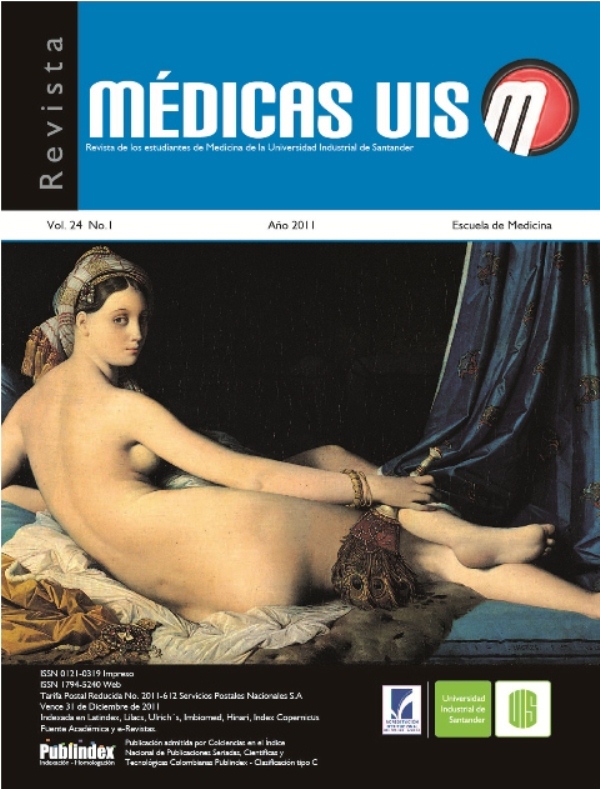Abstract
High-fat meal consumption induces acute changes in circulating lipid and then induces endothelial dysfunction after breakfasttime, this dysfunction is associated with atherosclerotic process development. Although the explain mechanism that is responsibleto induce endothelial function decrease, by post-prandial lipemia, is unknown. The elevation of lipoproteins high triglyceridesand their remnants, and oxidative stress are the main mechanisms. In the present study it is report two healthy adults withmedian age 30 years, whom take a menu that contain: 1049 calories, 31 g protein, 79 g fat (31 g saturated fat), 666 mgcholesterol, 69 g carbohydrates. Thus, it is described the effect induced by post-prandial lipemia on endothelial function andthe relationship of this metabolic state with clinical and biochemical features associated.
Key words: Dietary Fats. Vasodilatation. Endothelium. Postprandial period
References
2. Bots ML, Westerink J, Rabelink TJ, de Koning EJ. Assessment of flow-mediated vasodilatation (FMD) of the brachial artery: effects of technical aspects of the FMD measurement on the FMD response. Eur Heart J. 2005; 26:363-8.
3. Silva SY, Villamizar C, Villamizar N, Silva F, Luengas C, Casas JP, et al. Colombian study to assess the use of noninvasive determination of the endothelium-mediated vasodilation (CANDEV) II: does location of the occlusion device affects the accuracy of the diagnosis? Endothelium. 2005;12:107-11.
4. Vogel RA, Corretti MC, Plotnick GD. Effect of a single high-fat meal on endothelial function in healthy subjects. Am J Cardiol. 1997;79: 350–4.
5. Ross R. Atherosclerosis: An inflammatory disease. N Engl J Med. 1999;340:115-26.
6. Westphal S, Taneva E, Kastner S, Martens-Lobenhoffer S, Bode-Böger S, Kropf, J. Dierkes, et al. Endothelial dysfunction induced by postprandial lipemia is neutralized by addition of proteins to the fatty meal. Atherosclerosis. 2006;185:313-9.
7. Zilversmit DB. A proposal linking atherogenesis to the interaction of endothelial lipoprotein lipase with triglyceride-rich lipoproteins. Circ Res. 1997;33:633–8.
8. Hennig B, Alvarado A. Nutrition and endothelial cell integrity: Implications in atherosclerosis. Prog Food Nutr Sci. 1993;17:119-57.
9. Kusterer K, Pohl T, Fortmeyer HP, Marz W, Scharnagl H, Oldenburg A, et al. Chronic selective hypertriglyceridemia impairs endotheliumdependent vasodilatation in rats. Cardiovasc Res J. 1999;42:783-93.
10. Szabo C, Ischiropoulos H, Radi R. Peroxynitrite: biochemistry, pathophysiology and development of therapeutics. Nat Rev Drug Discov. 2007;6:662-80.
11. Kuzkaya N, Weissmann N, Harrison DG, Dikalov S. Interactions of peroxynitrite, tetrahydrobiopterin, ascorbic acid, and thiols: Implications for uncoupling endothelial nitric-oxide synthase. J Biol Chem. 2003;278:22546-54.
12. Cohn JS. Postprandial lipemia: emerging evidence for atherogenicity of remnant lipoproteins. Can J Cardiol. 1998;14(Suppl B):18B-27B.
13. Boquist S, Ruotolo G, Tang R, Bjorkegren J, Bond MG, de Faire U, et al. Alimentary lipemia, postprandial triglyceride-rich lipoproteins, and common carotid intima-media thickness in healthy, middle-aged men. Circulation. 1999;100:723-8.
14. de Gruijter M, Hoogerbrugge N, van Rijn MA, Koster JF, Sluiter W, Jongkind JF. Patients with combined hypercholesterolemia hypertriglyceridemia show an increased monocyte-endothelial cell adhesion in vitro: triglyceride level as a major determinant. Metabolism. 1991;40:1119-21.
15. Dart AM, Chin-Dusting JP. Lipids and the endothelium. Cardiovasc Res. 1999;3:308-22.
16. Doi H, Kugiyama K, Oka H, Sugiyama S, Ogata N, Koide SI, Nakamura SI, Yasue H. Remnant lipoproteins induce proatherothrombogenic molecules in endothelial cells through a redoxsensitive mechanism. Circulation. 2000;102:670-6.
17. de Koning EJ, Rabelink TJ. Endothelial function in the post-prandial state. Atheroscler Suppl. 2002;3:11-6.
18. Sodré FL, Paim BA, Urban A, Vercesi AE, Faria EC. Reduction in generation of reactive oxygen species and endothelial dysfunction during postprandial state. Nutr Metab Cardiovasc Dis. 2010 Jul 29.
19. Arcaro G, Cretti A, Balzano S, Lechi A, Muggeo M, Bonora E, Bonadonna RC. Insulin causes endothelial dysfunction in humans: sites and mechanisms. Circulation. 2002;105:576-82.
20. Magné J, Huneau JF, Delemasure S, Rochette L, Tomé D, Mariotti F. Whole-body basal nitric oxide production is impaired in postprandial endothelial dysfunction in healthy rats. Nitric Oxide. 2009;21:37-43.
21. Tsai WC, Li YH, Lin CC, Chao TH, Chen JH. Effects of oxidative stress on endothelial function after a high-fat meal. Clin Sci (Lond). 2004;106:315-19.
22. Kovacs I, Toldy E, Abel T, Tarjan J, Csaszar A. The effect of ciprofibrate on flow-mediated dilation and inflammatory markers in patients with combined hyperlipidemia. Endothelium. 2005;12:179-83.
